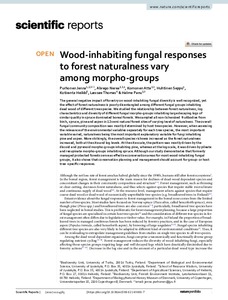Wood-inhabiting fungal responses to forest naturalness vary among morpho-groups
Huhtinen Seppo; Abrego Nerea; Purhonen Jenna; Læssøe Thomas; Halme Panu; Komonen Atte; Kotiranta Heikki
https://urn.fi/URN:NBN:fi-fe2021093048535
Tiivistelmä
The general negative impact of forestry on wood-inhabiting fungal diversity is well recognized, yet the effect of forest naturalness is poorly disentangled among different fungal groups inhabiting dead wood of different tree species. We studied the relationship between forest naturalness, log characteristics and diversity of different fungal morpho-groups inhabiting large decaying logs of similar quality in spruce dominated boreal forests. We sampled all non-lichenized fruitbodies from birch, spruce, pine and aspen in 12 semi-natural forest sites of varying level of naturalness. The overall fungal community composition was mostly determined by host tree species. However, when assessing the relevance of the environmental variables separately for each tree species, the most important variable varied, naturalness being the most important explanatory variable for fungi inhabiting pine and aspen. More strikingly, the overall species richness increased as the forest naturalness increased, both at the site and log levels. At the site scale, the pattern was mostly driven by the discoid and pyrenoid morpho-groups inhabiting pine, whereas at the log scale, it was driven by pileate and resupinate morpho-groups inhabiting spruce. Although our study demonstrates that formerly managed protected forests serve as effective conservation areas for most wood-inhabiting fungal groups, it also shows that conservation planning and management should account for group- or host tree -specific responses.
Kokoelmat
- Rinnakkaistallenteet [19207]
